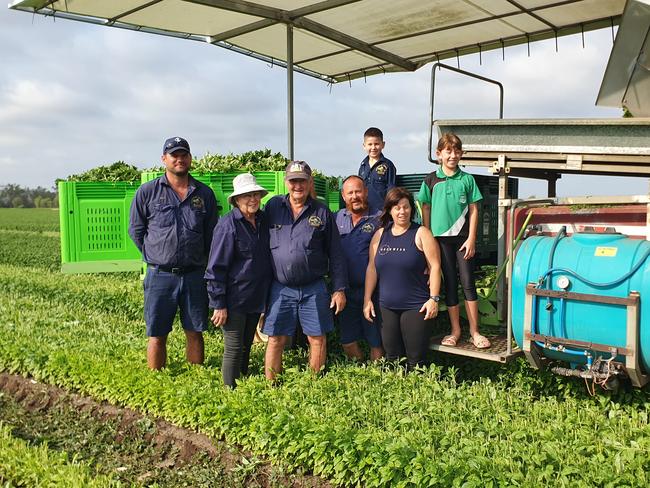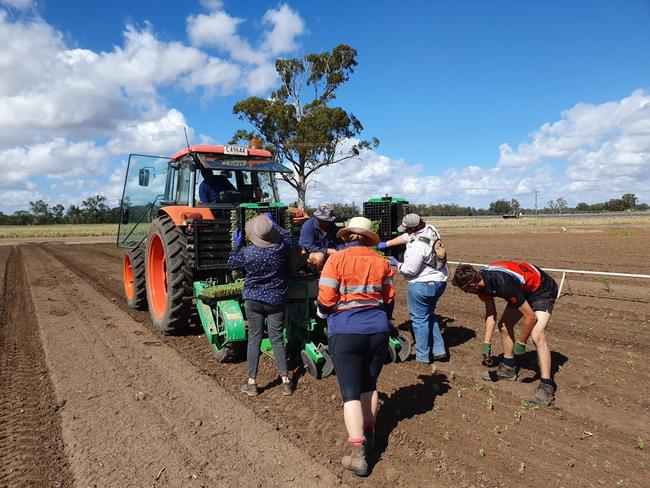Biloela herb growers yield rewards
For Trevor and Joy Goos changing industries has resulted in better yields and returns. This is how they did it.

Twenty-six years ago when Queensland broadacre crop farmer Trevor Goos had the chance to join the herb growing industry, he recalls being sceptical.
“It was around the same time the ostrich industry had taken off but fell away so there was a reason we were cautious with our approach,” Trevor said.
Once he and wife Joy saw the potential of herbs on their property at Biloela in central Queensland, they committed and have run a successful operation ever since.
“It’s like no other form of farming we’ve ever been involved in,” Trevor said.
“You sign a contract, you are obliged to deliver, and you grow 20 per cent more for your mates that may have had a bad time.
“It pays the bills and we are very happy to be part of it.”
GOURMET GROWING
The grower group works closely together.
“If anyone has a problem, we alert each other,” Trevor said.
“In case a grower has a hard time or issue, there are five others there to help maintain the full consistent supply from the group.”
If farmers retire and someone new wants to come on board, the decision is agreed upon by the remaining group members and the processing plant – located 500km away at Palmwoods on the Sunshine Coast.
“We harvest in the morning, the truck comes in the afternoon and the herbs are loaded into the fridge van – a semi trailer can hold 66 bins and a B-double 102 bins,” Trevor said.
“Sometimes there are two trucks a day leaving here, five days a week. The factory processes around 120 bins a day.”
PRECISION PLANNING
Trevor and Joy have 40 hectares dedicated to herb growing while the remaining 357ha of their property is share-farmed as part of a successful broadacre cropping operation producing wheat, sorghum and chickpeas.
The family operation includes son Jamie and daughter-in-law Edith, as well as farm manager Matthew Thomasson.
Herb growing requires precision in management for planting and harvesting and while the Goos’ shared equipment with neighbours in the early years, they soon developed or bought their own gear to prevent the bottleneck of everyone needing it at the same time.
Off the 40 hectares, they produce 10ha of coriander, 4ha of parsley, 6ha of basil and 2ha of chives, with the remaining area always either under fodder crop rotation or fallow.
“You shouldn’t plant the same crop in the same ground more than twice in a five-year period,” Trevor said.
“It is common sense. It helps break the disease cycle.”
Forage crops range from dolichos and forage sorghum to barley and oats.
“You can’t put a price into what you are mulching back into the soil,” Trevor said.
“You are building up the carbon levels and creating a satisfactory situation to maintain good crop health.”
ORGANIC SWITCH
Up until four years ago, the Goos’ were certified organic producers but have reverted to conventional farming practices due to the threat of downy mildew and supplier requirements.
“Changing to conventional, the yields haven’t changed and the returns haven’t changed,” Trevor said.
Trevor and Joy still use some degree of organic fertiliser to help with the biomass of the soil and help with nutrient levels.
“In the first years of organics we suffered badly with weed control but the flame weeder was a magic machine and it really did work by not disturbing the soil and promoting a new crop of weed,” Trevor said.
They are now able to use pre-emergent sprays where necessary and also have access to a reliable local manual weeding crew who have become an essential part of the business.
A HARVEST RACE
For coriander, planting is done by seed with a precision planter from early April and harvesting begins eight weeks later. Planting is conducted every week until September.
Pre-emergent sprays and weeding crews ensure there are zero weeds at harvest time.
Harvesting is similar to a conventional grain harvester, delivering to belts that feed 130kg bulk bins.
The bins, which have slots and holes to allow airflow, are taken to one of two on-site cool storage units that can hold up to 51 bins each and provide a forced air cooling process.
The aim is to remove heat as quickly as possible from the produce for longer shelf life.
“We can remove 3C an hour in our cool stores,” Trevor said.
“Basil harvest starts at 6am – you need to be finished by 10am to reduce wilted product. We can harvest 18 bins an hour.”

CLEAN CUT
Parsley is planted and harvested in a similar fashion to coriander but has a longer growing period.
Trevor said they side and top trimmed parsley to remove any old remnants from the previous crop to provide a “nice, fresh, clean 21 day cut for the next harvest”.
“You don’t want a bit of product that is four to five weeks old among a fresh cut,” he said.
In late spring and summer, basil is the primary crop, which is harvested three to six times until the end of March.
“Everyone has their own harvesters here now, which have been proudly designed and built by the six growers in the farm group here in the Callide Valley,” Trevor said.
Conventional granular fertiliser is used prior to planting and paddocks are bedded up with power harrows before irrigation pipes are laid. Liquid fertiliser and trace elements can be applied during the life of the crop if necessary.
Underground aquifers are used for irrigation water. The Goos’ have access to 187 megalitres for herb production with paddocks all GPS levelled to prevent water logging.
“It is set up with a tail water return drainage system to minimise run off and help with reef health,” Trevor said.
“We are also able to reuse some of that water – not watering directly onto herbs but in a pre-water situation.”
The annual rainfall is 700mm but currently conditions are dry.
YIELDING PERFECTION
Yields are fairly consistent at 4 tonnes/ha for coriander, harvested once a year; 4 tonnes/ha for parsley, harvested multiple times a year, and basil production is also 4 tonnes/ha, harvested three to six times a year.
Trevor and Joy are the only growers in the CD Herbs group to persevere with chives, which are challenging to grow and harvest. They yield about 7 tonnes/ha of chives.
Returns for all crops were buoyed by solid demand throughout the Covid period and while levels dropped back in the past 12 months, Trevor is confident it will increase again in the next few years.
“We are coming up to sign a new contract and we are looking for an optimistic result there,” he said.
“That gives us another five years of comfort in the industry.”




